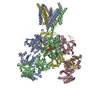+ Open data
Open data
- Basic information
Basic information
| Entry |  | |||||||||
|---|---|---|---|---|---|---|---|---|---|---|
| Title | Closed state of Gly/Glu/24S-HC bound hGluN1a-2B NMDAR | |||||||||
 Map data Map data | Composite map - Closed state of Gly/Glu/24S-HC bound hGluN1a-2B NMDAR | |||||||||
 Sample Sample |
| |||||||||
 Keywords Keywords | N-methyl-D-aspartate receptor / Closed state / 24S-HC / GluN2B / MEMBRANE PROTEIN | |||||||||
| Function / homology |  Function and homology information Function and homology informationglycine-gated cation channel activity / excitatory chemical synaptic transmission / Activated NTRK2 signals through FYN / Synaptic adhesion-like molecules / response to glycine / propylene metabolic process / negative regulation of dendritic spine maintenance / Assembly and cell surface presentation of NMDA receptors / regulation of monoatomic cation transmembrane transport / NMDA glutamate receptor activity ...glycine-gated cation channel activity / excitatory chemical synaptic transmission / Activated NTRK2 signals through FYN / Synaptic adhesion-like molecules / response to glycine / propylene metabolic process / negative regulation of dendritic spine maintenance / Assembly and cell surface presentation of NMDA receptors / regulation of monoatomic cation transmembrane transport / NMDA glutamate receptor activity / Neurexins and neuroligins / NMDA selective glutamate receptor complex / glutamate binding / ligand-gated sodium channel activity / neurotransmitter receptor complex / glutamate receptor signaling pathway / calcium ion transmembrane import into cytosol / protein heterotetramerization / glycine binding / positive regulation of reactive oxygen species biosynthetic process / monoatomic cation transmembrane transport / Negative regulation of NMDA receptor-mediated neuronal transmission / Unblocking of NMDA receptors, glutamate binding and activation / positive regulation of calcium ion transport into cytosol / Long-term potentiation / excitatory synapse / monoatomic ion channel complex / monoatomic cation transport / regulation of neuronal synaptic plasticity / positive regulation of excitatory postsynaptic potential / synaptic cleft / positive regulation of synaptic transmission, glutamatergic / calcium ion homeostasis / MECP2 regulates neuronal receptors and channels / glutamate-gated calcium ion channel activity / EPHB-mediated forward signaling / ligand-gated monoatomic ion channel activity involved in regulation of presynaptic membrane potential / ionotropic glutamate receptor signaling pathway / Ras activation upon Ca2+ influx through NMDA receptor / sodium ion transmembrane transport / synaptic membrane / regulation of membrane potential / transmitter-gated monoatomic ion channel activity involved in regulation of postsynaptic membrane potential / excitatory postsynaptic potential / synaptic transmission, glutamatergic / postsynaptic density membrane / brain development / visual learning / regulation of synaptic plasticity / calcium ion transmembrane transport / long-term synaptic potentiation / terminal bouton / synaptic vesicle / late endosome / signaling receptor activity / amyloid-beta binding / RAF/MAP kinase cascade / response to ethanol / dendritic spine / chemical synaptic transmission / postsynaptic membrane / learning or memory / cytoskeleton / calmodulin binding / lysosome / neuron projection / postsynaptic density / calcium ion binding / synapse / dendrite / endoplasmic reticulum membrane / protein-containing complex binding / cell surface / positive regulation of transcription by RNA polymerase II / zinc ion binding / plasma membrane / cytoplasm Similarity search - Function | |||||||||
| Biological species |  Homo sapiens (human) Homo sapiens (human) | |||||||||
| Method | single particle reconstruction / cryo EM / Resolution: 3.2 Å | |||||||||
 Authors Authors | Hyunook K / Hiro F | |||||||||
| Funding support |  United States, 2 items United States, 2 items
| |||||||||
 Citation Citation |  Journal: Nature / Year: 2025 Journal: Nature / Year: 2025Title: Mechanism of conductance control and neurosteroid binding in NMDA receptors. Authors: Hyunook Kang / Ruben Steigerwald / Elijah Z Ullman / Max Epstein / Srinu Paladugu / Dennis C Liotta / Stephen F Traynelis / Hiro Furukawa /  Abstract: Ion-channel activity reflects a combination of open probability and unitary conductance. Many channels display subconductance states that modulate signalling strength, yet the structural mechanisms ...Ion-channel activity reflects a combination of open probability and unitary conductance. Many channels display subconductance states that modulate signalling strength, yet the structural mechanisms governing conductance levels remain incompletely understood. Here we report that conductance levels are controlled by the bending patterns of pore-forming transmembrane helices in the heterotetrameric neuronal channel GluN1a-2B N-methyl-D-aspartate receptor (NMDAR). Our single-particle electron cryomicroscopy (cryo-EM) analyses demonstrate that an endogenous neurosteroid and synthetic positive allosteric modulator (PAM), 24S-hydroxycholesterol (24S-HC), binds to a juxtamembrane pocket in the GluN2B subunit and stabilizes the fully open-gate conformation, where GluN1a M3 and GluN2B M3' pore-forming helices are bent to dilate the channel pore. By contrast, EU1622-240 binds to the same GluN2B juxtamembrane pocket and a distinct juxtamembrane pocket in GluN1a to stabilize a sub-open state whereby only the GluN2B M3' helix is bent. Consistent with the varying extents of gate opening, the single-channel recordings predominantly show full-conductance and subconductance states in the presence of 24S-HC and EU1622-240, respectively. Another class of neurosteroid, pregnenolone sulfate, engages a similar GluN2B pocket, but two molecules bind simultaneously, revealing a diverse neurosteroid recognition pattern. Our study identifies that the juxtamembrane pockets are critical structural hubs for modulating conductance levels in NMDAR. | |||||||||
| History |
|
- Structure visualization
Structure visualization
| Supplemental images |
|---|
- Downloads & links
Downloads & links
-EMDB archive
| Map data |  emd_70669.map.gz emd_70669.map.gz | 229 MB |  EMDB map data format EMDB map data format | |
|---|---|---|---|---|
| Header (meta data) |  emd-70669-v30.xml emd-70669-v30.xml emd-70669.xml emd-70669.xml | 23.8 KB 23.8 KB | Display Display |  EMDB header EMDB header |
| Images |  emd_70669.png emd_70669.png | 69.3 KB | ||
| Filedesc metadata |  emd-70669.cif.gz emd-70669.cif.gz | 8 KB | ||
| Archive directory |  http://ftp.pdbj.org/pub/emdb/structures/EMD-70669 http://ftp.pdbj.org/pub/emdb/structures/EMD-70669 ftp://ftp.pdbj.org/pub/emdb/structures/EMD-70669 ftp://ftp.pdbj.org/pub/emdb/structures/EMD-70669 | HTTPS FTP |
-Validation report
| Summary document |  emd_70669_validation.pdf.gz emd_70669_validation.pdf.gz | 508.5 KB | Display |  EMDB validaton report EMDB validaton report |
|---|---|---|---|---|
| Full document |  emd_70669_full_validation.pdf.gz emd_70669_full_validation.pdf.gz | 508 KB | Display | |
| Data in XML |  emd_70669_validation.xml.gz emd_70669_validation.xml.gz | 7 KB | Display | |
| Data in CIF |  emd_70669_validation.cif.gz emd_70669_validation.cif.gz | 8.2 KB | Display | |
| Arichive directory |  https://ftp.pdbj.org/pub/emdb/validation_reports/EMD-70669 https://ftp.pdbj.org/pub/emdb/validation_reports/EMD-70669 ftp://ftp.pdbj.org/pub/emdb/validation_reports/EMD-70669 ftp://ftp.pdbj.org/pub/emdb/validation_reports/EMD-70669 | HTTPS FTP |
-Related structure data
| Related structure data |  9ooqMC  9oorC  9oosC  9ootC  9oouC C: citing same article ( M: atomic model generated by this map |
|---|---|
| Similar structure data | Similarity search - Function & homology  F&H Search F&H Search |
- Links
Links
| EMDB pages |  EMDB (EBI/PDBe) / EMDB (EBI/PDBe) /  EMDataResource EMDataResource |
|---|---|
| Related items in Molecule of the Month |
- Map
Map
| File |  Download / File: emd_70669.map.gz / Format: CCP4 / Size: 244.1 MB / Type: IMAGE STORED AS FLOATING POINT NUMBER (4 BYTES) Download / File: emd_70669.map.gz / Format: CCP4 / Size: 244.1 MB / Type: IMAGE STORED AS FLOATING POINT NUMBER (4 BYTES) | ||||||||||||||||||||||||||||||||||||
|---|---|---|---|---|---|---|---|---|---|---|---|---|---|---|---|---|---|---|---|---|---|---|---|---|---|---|---|---|---|---|---|---|---|---|---|---|---|
| Annotation | Composite map - Closed state of Gly/Glu/24S-HC bound hGluN1a-2B NMDAR | ||||||||||||||||||||||||||||||||||||
| Projections & slices | Image control
Images are generated by Spider. | ||||||||||||||||||||||||||||||||||||
| Voxel size | X=Y=Z: 0.827 Å | ||||||||||||||||||||||||||||||||||||
| Density |
| ||||||||||||||||||||||||||||||||||||
| Symmetry | Space group: 1 | ||||||||||||||||||||||||||||||||||||
| Details | EMDB XML:
|
-Supplemental data
- Sample components
Sample components
-Entire : hGluN1a-2B NMDAR
| Entire | Name: hGluN1a-2B NMDAR |
|---|---|
| Components |
|
-Supramolecule #1: hGluN1a-2B NMDAR
| Supramolecule | Name: hGluN1a-2B NMDAR / type: complex / ID: 1 / Parent: 0 / Macromolecule list: #1-#2 |
|---|---|
| Source (natural) | Organism:  Homo sapiens (human) Homo sapiens (human) |
| Molecular weight | Theoretical: 387 KDa |
-Macromolecule #1: Glutamate receptor ionotropic, NMDA 1
| Macromolecule | Name: Glutamate receptor ionotropic, NMDA 1 / type: protein_or_peptide / ID: 1 / Number of copies: 2 / Enantiomer: LEVO |
|---|---|
| Source (natural) | Organism:  Homo sapiens (human) Homo sapiens (human) |
| Molecular weight | Theoretical: 93.14932 KDa |
| Recombinant expression | Organism:  |
| Sequence | String: ARAASDPKIV NIGAVLSTRK HEQMFREAVN QANKRHGSWK IQLNATSVTH KPNAIQMALS VCEDLISSQV YAILVSHPPT PNDHFTPTP VSYTAGFYRI PVLGLTTRMS IYSDKSIHLS FLRTVPPYSH QSSVWFEMMR VYSWNHIILL VSDDHEGRAA Q KRLETLLE ...String: ARAASDPKIV NIGAVLSTRK HEQMFREAVN QANKRHGSWK IQLNATSVTH KPNAIQMALS VCEDLISSQV YAILVSHPPT PNDHFTPTP VSYTAGFYRI PVLGLTTRMS IYSDKSIHLS FLRTVPPYSH QSSVWFEMMR VYSWNHIILL VSDDHEGRAA Q KRLETLLE ERESKAEKVL QFDPGTKNVT ALLMEAKELE ARVIILSASE DDAATVYRAA AMLNMTGSGY VWLVGEREIS GN ALRYAPD GILGLQLING KNESAHISDA VGVVAQAVHE LLEKENITDP PRGCVGNTNI WKTGPLFKRV LMSSKYADGV TGR VEFNED GDRKFANYSI MNLQNRKLVQ VGIYNGTHVI PNDRKIIWPG GETEKPRGYQ MSTRLKIVTI HQEPFVYVKP TLSD GTCKE EFTVNGDPVK KVICTGPNDT SPGSPRHTVP QCCYGFCIDL LIKLARTMNF TYEVHLVADG KFGTQERVNN SNKKE WNGM MGELLSGQAD MIVAPLTINN ERAQYIEFSK PFKYQGLTIL VKKEIPRSTL DSFMQPFQST LWLLVGLSVH VVAVML YLL DRFSPFGRFK VNSEEEEEDA LTLSSAMWFS WGVLLNSGIG EGAPRSFSAR ILGMVWAGFA MIIVASYTAN LAAFLVL DR PEERITGIND PRLRNPSDKF IYATVKQSSV DIYFRRQVEL STMYRHMEKH NYESAAEAIQ AVRDNKLHAF IWDSAVLE F EASQKCDLVT TGELFFRSGF GIGMRKDSPW KQNVSLSILK SHENGFMEDL DKTWVRYQEC DSRSNAPATL TFENMAGVF MLVAGGIVAG IFLIFIEIAY KRHKDANGAQ UniProtKB: Glutamate receptor ionotropic, NMDA 1 |
-Macromolecule #2: Glutamate receptor ionotropic, NMDA 2B
| Macromolecule | Name: Glutamate receptor ionotropic, NMDA 2B / type: protein_or_peptide / ID: 2 / Details: Twin-strep tag at its N-terminus / Number of copies: 2 / Enantiomer: LEVO |
|---|---|
| Source (natural) | Organism:  Homo sapiens (human) Homo sapiens (human) |
| Molecular weight | Theoretical: 96.393797 KDa |
| Recombinant expression | Organism:  |
| Sequence | String: WSHPQFEKGG GSGGGSGGSA WSHPQFEKGA LVPRGRSQKS PPSIGIAVIL VGTSDEVAIK DAHEKDDFHH LSVVPRVELV AMNETDPKS IITRICDLMS DRKIQGVVFA DDTDQEAIAQ ILDFISAQTL TPILGIHGGS SMIMADKDES SMFFQFGPSI E QQASVMLN ...String: WSHPQFEKGG GSGGGSGGSA WSHPQFEKGA LVPRGRSQKS PPSIGIAVIL VGTSDEVAIK DAHEKDDFHH LSVVPRVELV AMNETDPKS IITRICDLMS DRKIQGVVFA DDTDQEAIAQ ILDFISAQTL TPILGIHGGS SMIMADKDES SMFFQFGPSI E QQASVMLN IMEEYDWYIF SIVTTYFPGY QDFVNKIRST IENSFVGWEL EEVLLLDMSL DDGDSKIQNQ LKKLQSPIIL LY CTKEEAT YIFEVANSVG LTGYGYTWIV PSLVAGDTDT VPAEFPTGLI SVSYDEWDYG LPARVRDGIA IITTAASDML SEH SFIPEP KSSCYNTHEK RIYQSNMLNR YLINVTFEGR NLSFSEDGYQ MHPKLVIILL NKERKWERVG KWKDKSLQMK YYVW PRMCP ETEEQEDDHL SIVTLEEAPF VIVESVDPLS GTCMRNTVPC QKRIVTENKT DEEPGYIKKC CKGFCIDILK KISKS VKFT YDLYLVTNGK HGKKINGTWN GMIGEVVMKR AYMAVGSLTI NEERSEVVDF SVPFIETGIS VMVSRSNGTV SPSAFL EPF SADVWVMMFV MLLIVSAVAV FVFEYFSPVG YNRSLADGRE PGGPSFTIGK AIWLLWGLVF NNSVPVQNPK GTTSKIM VS VWAFFAVIFL ASYTANLAAF MIQEEYVDQV SGLSDKKFQR PNDFSPPFRF GTVPNGSTER NIRNNYAEMH AYMGKFNQ R GVDDALLSLK TGKLDAFIYD AAVLNYMAGR DEGCKLVTIG SGKVFASTGY GIAIQKDSGW KRQVDLAILQ LFGDGEMEE LEALWLTGIC HNEKNEVMSS QLDIDNMAGV FYMLGAAMAL SLITFISEHL FYWQFRHSFM G UniProtKB: Glutamate receptor ionotropic, NMDA 2B |
-Macromolecule #3: GLYCINE
| Macromolecule | Name: GLYCINE / type: ligand / ID: 3 / Number of copies: 2 / Formula: GLY |
|---|---|
| Molecular weight | Theoretical: 75.067 Da |
| Chemical component information | 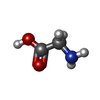 ChemComp-GLY: |
-Macromolecule #4: (2S)-3-(hexadecanoyloxy)-2-[(9Z)-octadec-9-enoyloxy]propyl 2-(tri...
| Macromolecule | Name: (2S)-3-(hexadecanoyloxy)-2-[(9Z)-octadec-9-enoyloxy]propyl 2-(trimethylammonio)ethyl phosphate type: ligand / ID: 4 / Number of copies: 8 / Formula: POV |
|---|---|
| Molecular weight | Theoretical: 760.076 Da |
| Chemical component information | 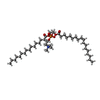 ChemComp-POV: |
-Macromolecule #5: GLUTAMIC ACID
| Macromolecule | Name: GLUTAMIC ACID / type: ligand / ID: 5 / Number of copies: 2 / Formula: GLU |
|---|---|
| Molecular weight | Theoretical: 147.129 Da |
| Chemical component information | 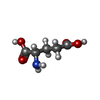 ChemComp-GLU: |
-Macromolecule #6: 24S-hydroxycholesterol
| Macromolecule | Name: 24S-hydroxycholesterol / type: ligand / ID: 6 / Number of copies: 2 / Formula: A1CE1 |
|---|---|
| Molecular weight | Theoretical: 402.653 Da |
-Macromolecule #7: water
| Macromolecule | Name: water / type: ligand / ID: 7 / Number of copies: 13 / Formula: HOH |
|---|---|
| Molecular weight | Theoretical: 18.015 Da |
| Chemical component information | 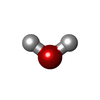 ChemComp-HOH: |
-Experimental details
-Structure determination
| Method | cryo EM |
|---|---|
 Processing Processing | single particle reconstruction |
| Aggregation state | particle |
- Sample preparation
Sample preparation
| Concentration | 3 mg/mL |
|---|---|
| Buffer | pH: 8.5 |
| Grid | Model: Quantifoil R1.2/1.3 / Material: COPPER / Mesh: 200 |
| Vitrification | Cryogen name: ETHANE / Chamber humidity: 100 % / Chamber temperature: 281 K / Instrument: FEI VITROBOT MARK IV |
- Electron microscopy
Electron microscopy
| Microscope | TFS KRIOS |
|---|---|
| Specialist optics | Energy filter - Name: GIF Bioquantum / Energy filter - Slit width: 14 eV |
| Image recording | Film or detector model: GATAN K3 BIOQUANTUM (6k x 4k) / Average electron dose: 58.0 e/Å2 |
| Electron beam | Acceleration voltage: 300 kV / Electron source:  FIELD EMISSION GUN FIELD EMISSION GUN |
| Electron optics | Illumination mode: FLOOD BEAM / Imaging mode: BRIGHT FIELD / Nominal defocus max: 2.2 µm / Nominal defocus min: 0.8 µm |
| Sample stage | Cooling holder cryogen: NITROGEN |
| Experimental equipment |  Model: Titan Krios / Image courtesy: FEI Company |
+ Image processing
Image processing
-Atomic model buiding 1
| Initial model |
| ||||||||||
|---|---|---|---|---|---|---|---|---|---|---|---|
| Refinement | Space: REAL / Protocol: RIGID BODY FIT | ||||||||||
| Output model |  PDB-9ooq: |
 Movie
Movie Controller
Controller




















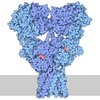




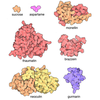

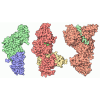
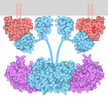
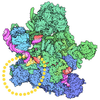

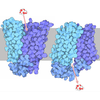
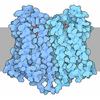
 Z (Sec.)
Z (Sec.) Y (Row.)
Y (Row.) X (Col.)
X (Col.)




















